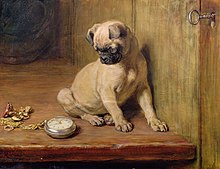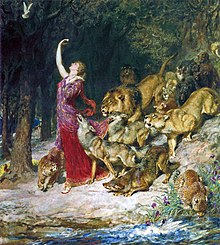Briton Rivière
Briton Rivière (born August 14, 1840 in London , † April 20, 1920 ibid) was a British painter.
origin
Briton's father, William Rivière (1806–1876), of Huguenot origin, was a drawing master at Cheltenham College and art teacher at the Slade School of Fine Art and at the University of Oxford for several years . His grandfather Daniel Valentin Rivière was also a painter and his uncle Henry Parsons Rivière (1811–1888) was also a painter. This exhibited work at the Royal Watercolor Society in London and the Royal Birmingham Society of Artists. Another uncle, Robert Rivière, was a well-known bookbinder.
life and work
Briton Jr. was educated at Cheltenham College and Oxford , where he graduated in 1867. For his artistic training he was almost exclusively committed to his father. Early in his career he made a name for himself as an illustrator, starting with work for the satirical magazine Punch . Due to his successfully exhibited paintings, he was elected "Associate" of the Royal Academy of Arts in 1877 and a full member of the Academy in 1880. In 1891 he received an honorary doctorate from Oxford University and in 1910 the Honor Fellowship of Oriel College at the university. After the death of Sir John Everett Millais , he was narrowly defeated in the election of his successor as President of the Royal Academy.
His first paintings appeared in exhibitions at the British Institution in 1851 and 1852 , and in 1857 he exhibited three works, and in 1858 another "The Broken Chain" at the Royal Academy of Arts . It was not until 1863 that he became a regular exhibitor at the academy. Between 1860 and 1863 he turned under the influence of his brother-in-law Clarence Dobell (1836-1917) to the work of the Pre-Raphaelites , but the paintings "Elaine on the Barge" and "Hamlet and Ophelia" were rejected by the Academy. In 1863 he was represented by the paintings "The Eve of the Spanish Armada" and in 1864 by "Romeo and Juliet". Motifs of this kind did not occupy him for long, however, because as early as 1865 he began with "Sleeping Deerhound" a series of paintings with animal motifs, which took up most of the rest of his work. In an in-depth interview in the Chums Boys Annual entitled “How I Paint Animals”, Rivière explained some of the practical aspects of painting animals in captivity and in the wild:
“I've always been a big lover of dogs, but I've worked so hard on them that I'm tired of having them around. However, you can never paint a dog if you don't like it. I never work on the picture of a dog without the help of someone who knows animals well (...). Collies, I think, are the most restless dogs (...). Greyhounds are also very restless and so are Fox Terriers (...). The only way to paint wild animals is to gradually accumulate a large number of studies and knowledge of the animal itself before one can paint its picture. I paint the body of a beautiful lioness from dead animals as well as from living animals in my studio (...). Gradually I worked a lot in the dissection rooms in the zoological garden. ”The London Circle of Friends included the Scottish painters William Quiller Orchardson (1832–1910), John Pettie (1839–1893), Peter Graham and John MacWhirter (1839–1911).
His wife Mary Alice Rivière (nee Dobell; 1844-1931), whom he married in 1867, was a painter and in 1869 briefly exhibited at the Royal Academy of Arts. The couple initially lived in Keston (Kent) and Bromley; In 1871 it settled in London. They had seven children: Hugh Goldwin, Bernard, Clive, Philip, Millicent, Evelyn, and Theodora. Hugh Goldwin Rivière (1869–1956) became a portraitist. After Britons death, Mary donated four of his drawings to the British Museum and one etching, "The King Drinks".
Works (selection)
Briton Rivière left drawings, prints and paintings, including portraits, figurative scenes with animals and individual depictions of animals, many of which have been shown in contemporary art exhibitions, particularly those at the Royal Academy. Many found their way into museums and private collections. His last painting, submitted to the Royal Academy two weeks before his death, was entitled "'Michael', an old Shepard with his Dog".
- London, Tate Gallery: “The Miracle of the Gardarene Swine” / “Giants at Play” / “A Blockade Runner” / “Beyond Man's Footsteps” / “Companions in Misfortune” / Study on “Sympathy” (pensive girl sitting on a staircase and dog), 1878 (Fig .: https://www.catplus.de ›Tiermalerei).
- “Tick-Tick” (mastiff with pocket watch), 1881: Russell-Cotes Art Gallery and Museum (Fig .: https://www.catplus.de ›Animal painting).
- "Pallas Athena and the Herdsman's Dogs", 1876: New York, Metropolitan Museum of Art.
- "Sympathy" (the listed painting): Royal Holloway University of London.
- "War Time", 1874: Norfolk, Virginia, USA: Chrysler Museum of Art.
- “The Last Spoonful”: Hamburg, Gustav Christian Schwabe Collection (1813–1897).
- "A Roman Holiday" (Gladiator with Lions in the Arena), 1881: Melbourne, National Gallery of Victoria; acquired in 1888.
- “Requiescat” (knight with dog in lay out), 1888, and study drawing for the dog: Sidney, Australia, Art Gallery of New South Wales.
- The King Drinks: Nottingham, National Design Academy, Rufford Hall, Waterside Way, Trent Park (Diploma Gallery).
- “Prometheus”, 1889: Oxford, Ashmolean Museum (Prometheus - Ashmolean Museum: collections.ashmolean.org ›offset› start ›end› object).
- "Aphrodite", 1902: New York, NY, USA, The Dahesh Museum of Art.
- "Daniel in the Lions Den": Liverpool, Walker Art Gallery
Art trade:
- "Circe and the Friends of Ulysses", 1871; afterwards etching by Frederick Stacpoole
- "Argus", 1873: Christie's, London, June 13, 1919, lot 155.
- “There's many a slip twixt the cup and the lip”, 1881: Christie's, London, 27 March 1896, lot 141.
- “Old Playfellows” (child with dog), 1883. Fig .: https://www.catplus.de ›Animal painting
Portrait
- Philip Hermogenes Calderon (1840-1920)
- Hubert Herkomer (1849–1914), 1887: London, Royal Academy
- Edward Onslow Ford (1852–1901): bronze bust. Oxford, Oriel College
literature
- Hugh Chisholm (Ed.): Riviere, Briton . Encyclopædia Britannica 23 (11th ed.). Cambridge University Press 1911, p. 387. Quoted in: Sir Walter Armstrong, Briton Riviere, RA: His Life and Work , in: Art Annual (1891); with list of works up to 1891.
- Death Of Mr. Briton Riviere: A Popular Animal Painter in: Times. April 21, 1920: 19. The Times Digital Archive. Online ed. Web. 5 October 2018.
- William Wilthew Fenn: Some modern artists and their work. Ed. Wilfrid Meynell. London: Cassell, 1883, pp. 141-147. Internet Archive. Web. 5 October 2018.
- The Collection of Merton Russell Cotes, Esq., JP , in: Art Journal. Vol. 57 (1895). 293-95. Internet Archive. Contributed by the Getty Research Institute. Web. 5 October 2018.
- Algernon Graves: The Royal Academy of Arts. Dictionary of Contributor 1905-1906.
- Catalogs of the exhibitions of the Royal Academy of Arts 1904 to 1920.
- The Dictionary of National Biography, founded 1882 by George Smith, edited by HWC Davis and JRH Weaver, 1912-1921.
- Bryan's Dictionary of Painters and Engravers, Volume II, 1899: → William Rivière.
- Geraldine Norman: Nineteenth-Century Painters and Painting: A Dictionary. Thames and Hudson, London 1977.
- Simon Reynolds: Riviere, Briton (1840–1920), painter. , in: Oxford Dictionary of National Biography. Web. 5 October 2018.
Web links
- http://www.victorianweb.org/painting/riviere/bio.html
- Briton Riviere - 46 artworks - WikiArt.org ( https://www.wikiart.org ›briton-riviere)
- https://www.tate.org.uk/art/artists/briton-riviere-453
- Briton Riviere: A collection of 66 paintings (HD) - YouTube ( https://www.youtube.com ›watch)
Individual evidence
- ↑ http://www.avictorian.com/Reviere_Briton.html
- ↑ English text in: Chums Boys Annual, No. 256, Volume V, August 4, 1897
- ↑ Art Journal (September 1889), p. 267, fig. Opposite p. 249: Etching in which the dog appears identical but reversed, while the figure and the background differ from the painting
- ^ Jeannie Chapel: Victorian Taste, The complete catalog of paintings at Royal Holloway College. ISBN 0 902 194 08 9
| personal data | |
|---|---|
| SURNAME | Rivière, Briton |
| BRIEF DESCRIPTION | British painter and draftsman |
| DATE OF BIRTH | August 14, 1840 |
| PLACE OF BIRTH | London |
| DATE OF DEATH | April 20, 1920 |
| Place of death | London |



